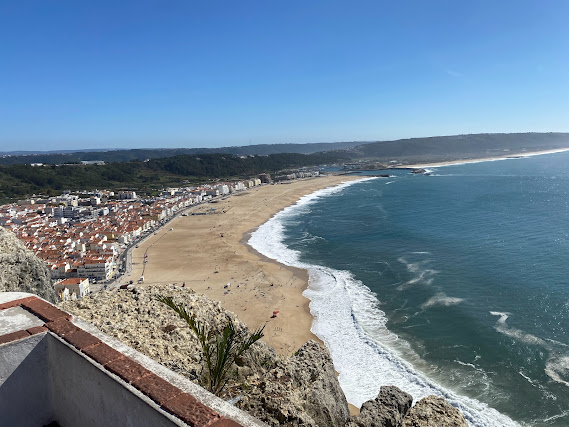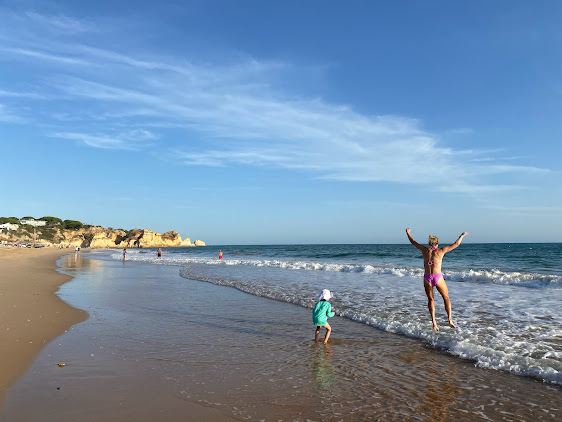The family took a great, 2 week trip to Spain and Portugal. We did a road trip, and traveled to 9 destinations:
September 21 – 24 – Pontevedra and Sanxenxo, Spain
The first leg of our trip traveled to the Galicia region of
Spain so Kristen could compete in the 2023 World Triathlon Age Group
Championships. She qualified at US
Nationals last year, and going to Worlds was always a bucket-list item for her,
so we decided to make a family trip out of it.
After landing in Lisbon on the 21st, we immediately rented a car and drove about 2/3 of the way to Spain, stopping to sleep in Braga, Portugal, which is located in Portugal’s wine region. All of Northwestern Portugal looks like Marin County. Wine regions are wine regions, I guess.
We were exhausted and did not see any of the city, but we
did have a nice dinner, and then a great continental breakfast that dead-on
reminded us of Brazil. This would be a
theme of the trip – we spent so much time in Brazil in the past, the
comparisons with Portugal were constant.
On the 22nd, we drove up to our beautiful rental house in Sanxenxo, Spain, which is a resort town about 30 minutes from the location of the triathlon, in Pontevedra, Spain.
The night of the 22nd was the “Parade of Nations,” where all the triathlon participants paraded through the streets of Pontevedra. We met up with Kristen’s brother Matt and his wife Meysel to watch the festivities, and then went back to the house and crashed.
The next few days were a flurry of activity – I’m not sure we appreciated the insane logistics that would go into the Worlds race. Every day, Kristen had multiple things she had to take care of or do. On the 22nd, we were also joined by Kristen’s sister Julie and her fiancée Travis, and all the siblings and in-laws were super helpful with the logistics. This was a big deal on top of the exhaustion and jetlag.
We were able to do a few fun things during this preparation
period, though. Pontevedra is a
wonderful little town with ancient buildings and lots of cute restaurants:
Finally, the day of the race came. All 7 of us watched Kristen on every leg of
the race, at as many points as we could.
Kristen’s expectations were that she would be happy to finish mid-pack
of the ~50 racers in her age group. But
she ended up getting 6th place!
It was a really wonderful day.
A note on food at this point: we had almost no vegetables
for days. We were eating at a variety of
restaurants, and most of the food was pretty good, but were almost never served
vegetables (other than potatoes). Vegetables
and fruit did not come with meals, they were not offered as sides, and were generally
not available beyond a basic salad. The
fruit we bought at a local market was mediocre.
Almost all meals were just carbs and protein. We didn’t understand what was going on. After 3-4 days of this, I started making it a
point to eat exclusively salad every day for lunch – whatever salad was on
offer. Julie and Travis (who had just
spend 4 weeks traveling through other parts of Europe) said this was pretty
common elsewhere.
September 25-27: Braga, Obidos, Nazare
We left Sanxenxo on the 25th and said goodbye to
Matt and Meysel, who were headed for Madrid.
Julie and Travis would stick with us for the next couple parts of the
trip.
First, we stopped in Braga for lunch. We ate at the famous restaurant A Brasilera,
which, despite the name, did not serve Brazilian food. They did, however, serve vegetables.
Braga is a really nice town – it seemed large enough to have
a variety of cultural elements, but still felt like a small European town, with
winding streets and beautiful old buildings.
And not many tourists.
From Braga, we proceeded on to our next accommodation, just
outside Peniche. We stayed in a 2
bedroom, 1 bathroom windmill!
The windmill was a little cramped and dark, but the kids (and
I) thought it was super cool. You could
even see the old gearing, which they had partially left in place, and partially
turned into furniture.
The exposed mechanicals of the windmill in one bedroom
During this part of the trip, we first visited Obidos
castle, which was like the archetype of a cool medieval castle and walled
city. And the best part was that Obidos allows
you to walk on the walls of the city.
The entire walk is about a mile long, along a narrow walkway (that
soldiers presumably patrolled 500 years ago) with significant height
exposure. This is how we found out that
Soraya is not afraid of heights. I LOVED
this part of the trip, and it was one of the most memorable things we did.
After Obidos, we went to the famous Nazare beach, where the largest waves in the world sometimes swell up. We spent a bit of time on the main town beach, playing in the sand, though we were not able to go in the water because the surf was so high (the waves were around 6-8ft).
September 27-29: Evora
From the windmill, we drove East to the small town of
Evora. As we drove East, the temperature
rose, and the land turned to desert.
Eastern Portugal looks like the Sierra foothills (specifically Amador
county), with dry landscapes, strewn-about boulders, and valley oak-looking
trees (which turned out to be cork trees, a close relative).
On the way, we stopped to check out some Neolithic
monuments. The primary Stonehenge-like
area, called Cromeleque dos Almendres, was closed for restoration, but we got to see a cool, 12ft tall ceremonial
stone built by humans about 8,000 years ago.
The town of Evora itself is an absolutely charming, magical village. The entire town is surrounded by a crenelated wall, and inside is a maze of cobbled streets and medieval buildings.
It was like the medieval Ann Arbor or Madison – a cute college town with a lot of energy. Prices were low and tourists were relatively few. The food was great, there were Roman ruins, and we were able to have some downtime with the kids, stopping at the local beautiful library, and going to a local playground. We also visited the famous Capela dos Ossos, a memento mori chapel built from the bones of 5000 people. The girls thought it was pretty cool. Julie and Travis even watched the kids one night so Kristen and I could go on a date to a nice restaurant! Evora felt like the most “authentic” Portugal experience we had.
A note on language: at the point in the trip, we weren’t
sure of what to make of the language aspect.
Kristen and I both speak good Spanish and passable Portuguese. And we had read and assumed that most people
would appreciate us speaking the local language. But we were typically met with a mixed
response. Almost everywhere in Portugal,
service workers speak English, usually better than we speak Portuguese, and
they seemed to sometimes get annoyed that we were trying to converse in
Portuguese. But, we insisted anyway, and
were starting to get some of our vocab back from the Brazil days by this point
in the trip. So I’m not really sure what
the best thing to do here was, since we were potentially making people’s jobs
harder, but practicing Portuguese is what we did. To the point that once when I responded to a
waiter in English, Sylvia asked me why I did that.
September 29-Oct 2: The Algarve
From Evora, we said goodbye to Julie and Travis, and drove down
to the beach region of Portugal, called the Algarve. The Algarve is known for its picturesque
limestone cliffs that line the sea, and create tiny beaches that dot the coast,
full of caves and other nooks and crannies.
The surf was pretty high when we were in the area, and swimming was prohibited the first day we were there. We had intended to rent Kayaks to paddle out to Benagil cave, but that looked like it wasn’t going to happen, so we decided to go beach-hopping.
We ended up going to several wonderful beaches, where the girls had a great time jumping in the waves, building sandcastles, and playing make-believe. It was a nice, relaxing few days on the shore.
Oct 2-3: Lisbon
On Oct 2, we left The Algarve and headed for Lisbon. To this point, we had deliberately avoided
Portugal’s major cities (Lisbon and Porto), because we thought trying to go on
walking tours to see architectural points of interest was probably not going to
go great with a 3 and a 5 year old. Kristen
and I also just aren’t that enamored of big cities for whatever reason. But we spent most of the day touring around
Lisbon with the kids, which was about enough.
We took the famous Tram 28 through the city, and then walked
through a few neighborhoods, stopping for dinner in the Chiado neighborhood.
Lisbon looks like a more organized, older version of Sao Paulo. It has a very similar feel. Lisbon is also far more cosmopolitan than the other provincial places we visited – you could get more than traditional Portuguese food, and there seemed to be a melting pot of people and things. We probably could have spent another half-day to full day exploring Lisbon, but given all the other things we wanted to see and do, I think a half day of walking around was plenty.
Interestingly, the people in Lisbon seemed happier to talk with us in Portuguese than elsewhere.
And so ended our trip to Portugal and Spain. It was a great time with the family, Kristen’s first visit to continental Europe, and a new cultural experience for the kids!





.heic)
.JPG)











.HEIC)







